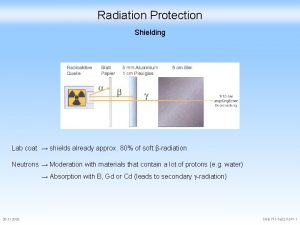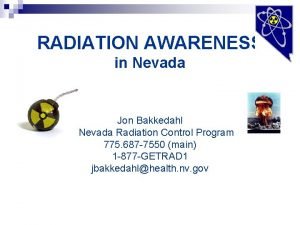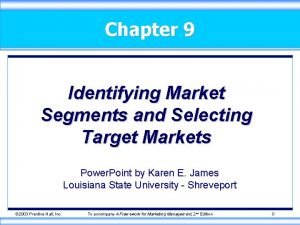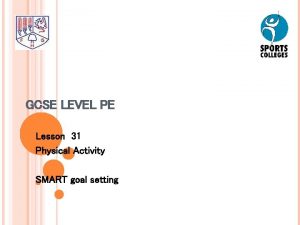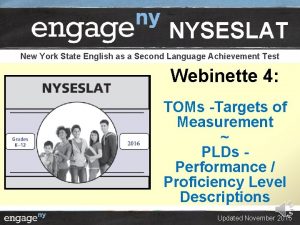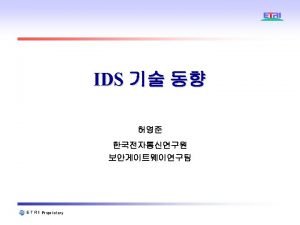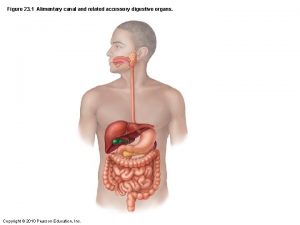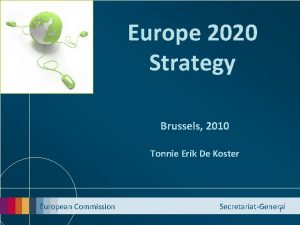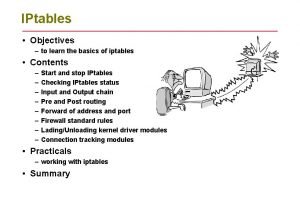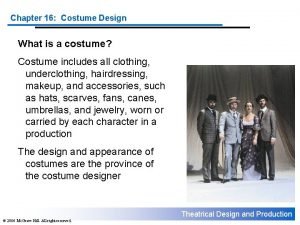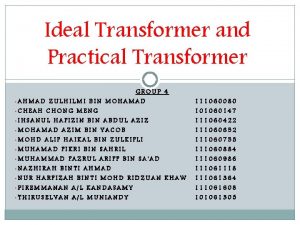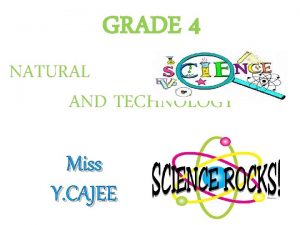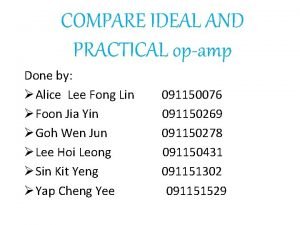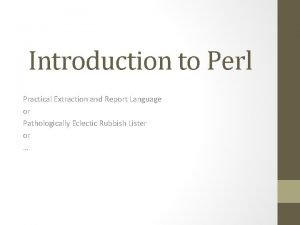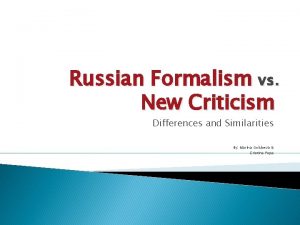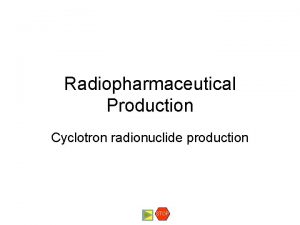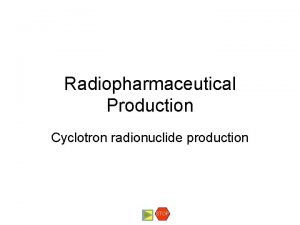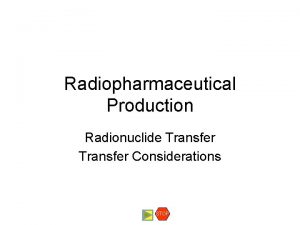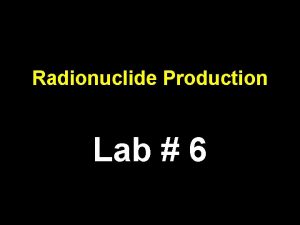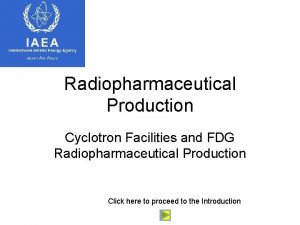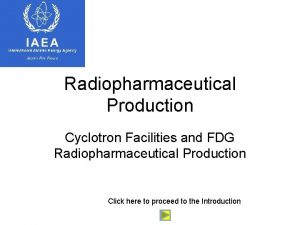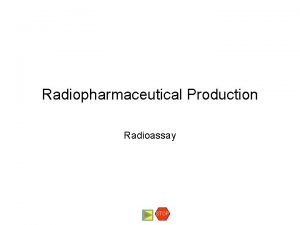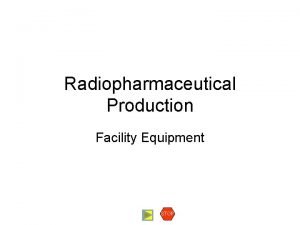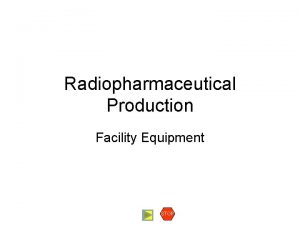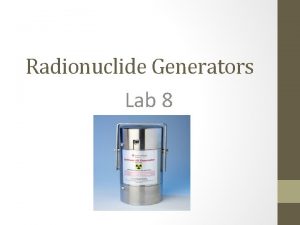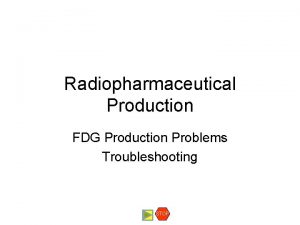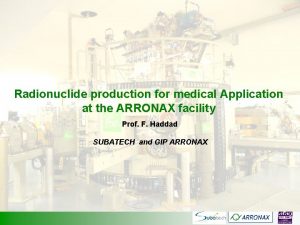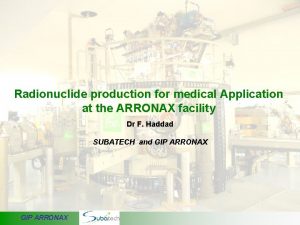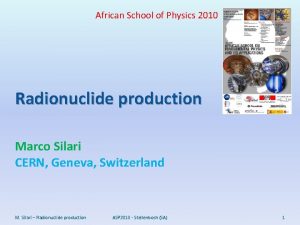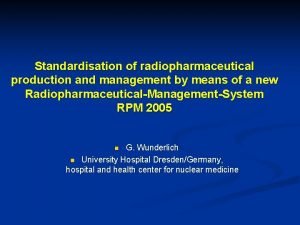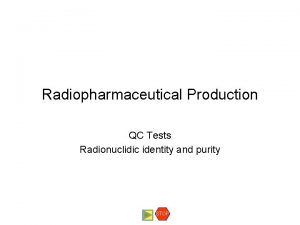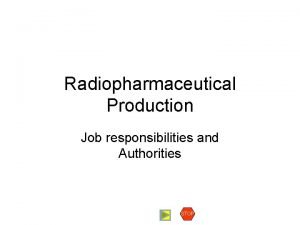Radiopharmaceutical Production Radionuclide Production Practical Targets Design and














































- Slides: 46

Radiopharmaceutical Production Radionuclide Production Practical Targets Design and Construction STOP

Requirements in Targetry • • Need to produce radionuclides reliably to meet our research needs Need to produce large quantities to meet current and future demands May need high specific activity for diagnostic or research applications Simple targets which do not degrade in performance Recycle enriched isotopes Minimize the amount of non-radioactive isotope in the final product (high specific activity) Targets which will withstand high power deposition and use favorable nuclear reactions Contents • • • STOP Basic Principles Carbon-11 Example Fluorine-18 example Iodine-124 example Summary

Basic Principles Radiopharmaceutical Production There are several decisions which must be made when starting to design a cyclotron target. These include: Practical Targets Contents Basic Principles Carbon-11 Example § § Fluorine-18 example Iodine-124 example Summary § § STOP Choice of Nuclear Reaction Choice of the physical state § Gas target § Water target § Solid target Choice of processing § Gas target - chemical separation § Solid target - distillation or sublimation Choice of the chemical form § Element or Compound § § § Target Geometry § What is the best shape for the target Target Body Material § Chemical Interactions § Thermal Conductivity § Activation Front Foil Material § Strength § Chemical Interactions

Radiopharmaceutical Production Practical Targets Carbon-11 Example As an example, let us assume we want to produce carbon-11. There are several potential nuclear reactions which may be used to produce C-11. Isotope Contents half-life Basic Principles Carbon-11 Example Fluorine-18 example Iodine-124 example Summary STOP Carbon-11 20. 4 min Fluorine-18 110 min Nitrogen-13 10 min Oxygen-15 2 min The possibilities are given in the following slides

Potential Reactions Radiopharmaceutical Production Practical Targets Contents Basic Principles Carbon-11 Example Fluorine-18 example Iodine-124 example Summary STOP We can explore the potential nuclear reaction pathways by looking at a chart of the nuclides. We want all the reactions to end on carbon-11, but they can start from different stable elements (black squares)

Types of Nuclear Reactions Radiopharmaceutical Production Practical Targets Contents Basic Principles Carbon-11 Example The radionuclides that can potentially be made from different nuclear reactions are shown in the following diagram. The first letter is the particle in and the letter after the comma is the particle(s) emitted by the excited nucleus. This template can be overlaid on a chart of the nuclides to get the products Fluorine-18 example Iodine-124 example 3 He, n α, n p, γ d, n p, pn Target d, p Summary Nuclear Charge α, 2 n STOP p, 3 n p, 2 n p, α p, 2 p Nuclear Mass

Potential Reactions Radiopharmaceutical Production 11 B(p, n)11 C Practical Targets Contents Basic Principles Carbon-11 Example Fluorine-18 example Iodine-124 example Summary Proton in Neutron out STOP

Potential Reactions Radiopharmaceutical Production 14 N(p, α)11 C Practical Targets Contents Basic Principles Carbon-11 Example Fluorine-18 example Iodine-124 example Summary Proton in Alpha particle out STOP

Potential Reactions Radiopharmaceutical Production 12 C(p, pn)11 C Practical Targets Contents Basic Principles Carbon-11 Example Fluorine-18 example Iodine-124 example Summary Proton in Proton and Neutron out STOP

Radiopharmaceutical Production Practical Targets Contents Basic Principles Carbon-11 Example Fluorine-18 example Carbon-11 Production The cross sections for these three reactions are given in the table below • Three potential nuclear reactions – 14 N(p, α)11 C – 11 B(p, n)11 C – 12 C(p, pn)11 C Iodine-124 example Summary STOP In terms of the yield of the nuclear reactions, it is clear that the best choice is the 11 B(p, n)11 C reaction

PET Radioisotope Production Radiopharmaceutical Production Practical Targets Contents Basic Principles Carbon-11 Example Fluorine-18 example • • One must choose the chemical form for the target. The best choice is a Solid Phase Target The target is boron oxide which is a solid The 11 B(p, n)11 C reaction in a boron oxide matrix will produce carbon dioxide An example of a target designed for this reaction is shown on the next slide Iodine-124 example Summary STOP The difficulty with these type of solid targets is removing the carbon-11 carbon dioxide efficiently from the boron oxide matrix

11 CO Radiopharmaceutical Production Practical Targets Contents Basic Principles Carbon-11 Example Fluorine-18 example Iodine-124 example Summary x flow-through target Target design features Use of B 2 O 3 to provide oxygen for COx protons production Enriched 11 B to increase yield Slanted target material to increase 11 COx diffusion High temperature to increase 11 COx diffusion Helium carrier gas to remove 11 COx from target The actual yields are quite low due to the difficulty of getting the 11 CO 2 out Helium in 11 B + 11 B 216 O 3 11 CO in Helium x out to flow-through chemistry John Clark - circa 1975 STOP

Carbon-11 Production Radiopharmaceutical Production Practical Targets Contents Basic Principles The next option to be considered is the Nitrogen Gas Target for 14 N(p, α)11 C reaction. This target has the advantage of using a gas as the target material which makes the extraction of the carbon-11 carbon dioxide much easier. Gas inlet Carbon-11 Example Fluorine-18 example Iodine-124 example Summary Water cooling channels Gas outlet Gas target body is made from polished aluminum STOP

Carbon-11 Production Radiopharmaceutical Production This is a cutaway drawing of a typical target for the production of carbon-11 from nitrogen-14 in the chemical form of nitrogen gas. Practical Targets Contents Basic Principles Carbon-11 Example Fluorine-18 example Iodine-124 example Summary STOP Nitrogen Gas Target for 14 N(p, α)11 C reaction

Radiopharmaceutical Production Practical Targets Contents Basic Principles Carbon-11 Example Fluorine-18 example Iodine-124 example Summary STOP Range of protons in N 2 Gas at 1 atm The first decision is how long to make the target and what pressure to use. If we want to stop the beam we can calculate the range of the protons in the gas. At 1 atmosphere, the target would need to be 2. 6 meters long to stop the beam. Energy (Me. V) 4. 50 5. 00 5. 50 6. 00 6. 50 7. 00 8. 00 9. 00 10. 00 11. 00 12. 00 13. 00 14. 00 15. 00 16. 00 Range 277. 00 mm 332. 37 mm 392. 20 mm 456. 41 mm 524. 95 mm 597. 76 mm 755. 83 mm 930. 42 mm 1. 12 m 1. 33 m 1. 55 m 1. 79 m 2. 04 m 2. 31 m 2. 59 m

Range of protons in N 2 Gas at 10 atm Radiopharmaceutical Production At a pressure of 10 atmospheres, the beam will stop in about 26 cm. W much more reasonable target length although most nitrogen targets are this and operate at higher pressures. Practical Targets Contents Basic Principles Carbon-11 Example Fluorine-18 example Iodine-124 example Summary STOP Energy (Me. V) 4. 00 4. 50 5. 00 5. 50 6. 00 6. 50 7. 00 8. 00 9. 00 10. 00 11. 00 12. 00 13. 00 14. 00 15. 00 16. 00 Range 22. 62 mm 27. 70 mm 33. 24 mm 39. 22 mm 45. 64 mm 52. 50 mm 59. 78 mm 75. 58 mm 93. 04 mm 112. 12 mm 132. 79 mm 155. 03 mm 178. 81 mm 204. 12 mm 230. 92 mm 259. 21 mm

Shape of the Target Radiopharmaceutical Production We need to decide the shape of the target. We know that the beam will spread out due to small angle multiple scattering. This straggling can be calculated most easily using a program such as SRIM Practical Targets Contents Basic Principles Carbon-11 Example Fluorine-18 example Iodine-124 example Summary STOP Energy (Me. V) 4. 00 4. 50 5. 00 5. 50 6. 00 6. 50 7. 00 8. 00 9. 00 10. 00 11. 00 12. 00 13. 00 14. 00 15. 00 16. 00 Straggling 730. 98 um 885. 82 um 1. 05 mm 1. 23 mm 1. 42 mm 1. 63 mm 1. 84 mm 2. 31 mm 2. 82 mm 3. 37 mm 3. 97 mm 4. 61 mm 5. 29 mm 6. 01 mm 6. 78 mm 7. 58 mm 8. 0 mm

Entrance Foil Material Radiopharmaceutical Production Practical Targets Contents Basic Principles The table below gives the physical characteristics of some common foil materials. The ideal has high strength, low density, good thermal conductivity, a reasonable d. E/dx and high melting point. None is perfect but Al, Ti and Havar are common. Material density Melt. Pt. (g/cm 3) (°C) Tensile St. (kpsi) Thermal Cond. d. E/dx (watt/cm-°K) (Me. V/g/cm 2) Carbon 2. 2 >3000 --- 2. 51 41. 08 Aluminium 2. 71 660 30 2. 37 33. 96 Titanium 4. 5 1668 120 0. 31 29. 77 316 Stainless 8. 02 1427 120 0. 29 28. 91 Havar 8. 3 1493 250 0. 17 28. 6 Nickel 8. 9 1453 120 0. 91 28. 53 Tantalum 16. 6 2996 70 0. 53 18. 57 Tungsten 19. 3 3387 500 1. 8 18. 42 Platinum 21. 4 1769 20 0. 72 18. 3 Niobium 8. 57 2477 40 0. 54 Carbon-11 Example Fluorine-18 example Iodine-124 example Summary STOP

Radiopharmaceutical Production Practical Targets Contents Basic Principles Carbon-11 Example Getting High Specific Activity In order to get high specific activity carbon-11, it is necessary to take precautions when fabricating the target. These include: • • Fluorine-18 example Iodine-124 example Summary • • Use Electrical Discharge machining to cut the metal Use only alumina (Al 2 O 3) abrasives in polishing the inside surface. Never use oils in the target If organic solvents must be used, follow the use with repeated rinses of ethanol and water Cleaning the target • Should never need to be cleaned • If it is necessary, then Acetone and Ethanol should be used as they are soluble in water • If abrasives are used, they should be alumina • The target should be irradiated and the gas discarded after any cleaning procedure and before a production irradiation STOP

Fluorine-18 Example Radiopharmaceutical Production Practical Targets Contents Basic Principles Carbon-11 Example Fluorine-18 example Iodine-124 example Summary STOP Isotope half-life Carbon-11 20. 4 min Fluorine-18 110 min Nitrogen-13 10 min Oxygen-15 2 min

Fluorine-18 Example Radiopharmaceutical Production Practical Targets There is really one reasonable nuclear reaction with protons as the bombarding particle. This is the 18 O(p, n)18 F reaction. Contents Basic Principles Carbon-11 Example Fluorine-18 example Iodine-124 example Summary Proton in Neutron out STOP

Radiopharmaceutical Production Practical Targets Contents Basic Principles 18 O(p, n)18 F The most convenient chemical form of the target material is in the form of oxygen-18 enriched water. This is the reaction that is used by nearly all facilities for the production of FDG Carbon-11 Example Fluorine-18 example Iodine-124 example Summary STOP Reaction The nuclear reaction cross section is shown on the right and it should be noted that the peak of the reaction is about 6 Me. V and it tails off rapidly above 11 Me. V.

Fluorine-18 Fluoride Production Radiopharmaceutical Production • Practical Targets Contents Basic Principles • Carbon-11 Example Fluorine-18 example Iodine-124 example Summary • • STOP The target is usually a depression cut into a metal Front flange Target water block which contains the oxygen-18 enriched water There is a inlet and outlet for the water and the target is deep enough to allow some boiling in the target without loosing yield. Beam The rear of the target is cooled with a high pressure water flow The front foil is made of a material that is strong enough to hold the pressure generated by the boiling water and chemically resistant to the Cooling water fluoride and the oxygenated species like peroxide generated in the water.

Radiopharmaceutical Production Practical Targets Contents Basic Principles Carbon-11 Example Fluorine-18 example Iodine-124 example Summary STOP Fluorine-18 Fluoride Production Typical water target. This particular target is made from solid silver to help in the heat transfer. A more modern water target is typically made from niobium. • 18 O(p, n)18 F Nuclear Reaction in 95% enriched water • Volume of the target from 0. 3 m. L up to 3. 0 m. L

Radiopharmaceutical Production Water Target Operation Filling and Irradiation Cycle Vent Practical Targets Contents Basic Principles Carbon-11 Example Fluorine-18 example Iodine-124 example Helium push gas Summary Beam [18 O]Water To the Chemistry Lab STOP

Radiopharmaceutical Production Practical Targets Water Target Operation After Irradiation, pushing the water from the target to the Chemistry Lab Vent Contents Basic Principles Carbon-11 Example Fluorine-18 example Iodine-124 example Helium push gas Summary Beam [18 O]Water To the Chemistry Lab STOP

Radiopharmaceutical Production Transfer of the F-18 from the Cyclotron to the Chemistry Laboratory Practical Targets Contents Basic Principles Carbon-11 Example Fluorine-18 example Iodine-124 example Summary STOP F-18 transfer line - 60 meters

Radiopharmaceutical Production Practical Targets Contents Basic Principles Carbon-11 Example Fluorine-18 example Iodine-124 example Summary Initial Fabrication and Cleaning of F-18 targets Fabrication of Fluorine targets • Should never use soldering fluxes as they contain fluorine which will reduce specific activity • The back wall should be thin to allow good heat transfer • A “reflux” volume helps with keeping the target material in the liquid state Cleaning of Fluorine targets • Silver targets need to be cleaned fairly frequently • Niobium and Titanium can be cleaned much less frequently • No cleaning may be necessary if these last two are used • Mild abrasive and repeated water rinses are best STOP

Radiopharmaceutical Production Practical Targets Contents Basic Principles Carbon-11 Example Fluorine-18 example Iodine-124 example Summary STOP Iodine-124 Example As the next example, suppose you wanted to make I-124 on the cyclotron and wanted to design a target for the production

Radiopharmaceutical Production Chart of the Nuclides Here we can use the 124 Te(p, n)124 I nuclear reaction Practical Targets Contents Basic Principles Carbon-11 Example Fluorine-18 example Iodine-124 example Summary n p STOP

Cross-section 124 Te(p, n)124 I Radiopharmaceutical Production Practical Targets Contents Basic Principles Carbon-11 Example Fluorine-18 example Iodine-124 example Summary STOP This excitation function for the nuclear reaction shows that the best energy interval is from 15 down to about 5 Me. V

Tellurium Solid Targets Radiopharmaceutical Production Practical Targets Here we have the option of two different chemical forms of the tellurium to use for the target. We can use tellurium metal as shown on the left or tellurium dioxide as shown on the right Contents Basic Principles Carbon-11 Example Fluorine-18 example Iodine-124 example Summary STOP Both of these target materials are used for production and the choice depends on ease of chemical processing and target material recovery. Since the target material is isotopically enriched, it is relatively expensive and so must be recovered

Preparation of solid targets by electrodeposition Radiopharmaceutical Production Practical Targets Contents Basic Principles The tellurium metal target may be prepared by electrodeposition. There are several constraints on the targets prepared this way. Some of these are given below. Carbon-11 Example Fluorine-18 example Iodine-124 example Summary STOP · Requirements · The layer must be homogeneous over the entire surface area to ± 5%. · The layer must adhere strongly to the carrier up to the irradiation temperatures. · The layer must be smooth (not spongy), dense (no occlusions nor vacuoles), and stress free. · The layer must be free of any organic plating additives (complexing agents or surfactants).

Electrodeposition Apparatus Radiopharmaceutical Production Practical Targets • Contents Basic Principles Carbon-11 Example • Fluorine-18 example Iodine-124 example Summary • • STOP A diagram of an electrodeposition apparatus is shown on the right This particular apparatus will prepare four targets simultaneously. The composition of the solutions used to prepare these targets are beyond the scope of this presentation, but may be found in the IAEA publication TRS 432 A picture of the actual apparatus is shown on the next slide.

Electrodeposition Apparatus Radiopharmaceutical Production Practical Targets Contents Basic Principles Carbon-11 Example Fluorine-18 example Iodine-124 example Summary STOP

Radiopharmaceutical Production Practical Targets Contents Basic Principles Carbon-11 Example Radioiodine Production • • • The target can be an internal target which can have a very low angle of incidence and high power dissipation The target is mounted inside the vacuum tank of the cyclotron and is irradiated under high vacuum Loss of the I-124 during irradiation is a concern Fluorine-18 example Iodine-124 example Summary STOP Courtesy of John Clark

Radiopharmaceutical Production Practical Targets Contents Radioiodine Production • • The idea of an inclined plane can be used as well with the target attached directly to the cyclotron This target attaches to the beam port of the cyclotron Basic Principles Carbon-11 Example Fluorine-18 example Iodine-124 example Summary STOP Courtesy of Advanced Cyclotron Systems, Inc.

Range of Protons in Te. O 2 Radiopharmaceutical Production Practical Targets Contents Basic Principles Carbon-11 Example Fluorine-18 example Iodine-124 example Summary STOP The target can also be formed from a tellurium dioxide powder target. This target has the advantage of being able to be reused without extensive processing by distilling the iodine out of the Te. O 2. . The target needs to be about 1. 5 mm thick Energy (Me. V) 4. 50 5. 00 5. 50 6. 00 6. 50 7. 00 8. 00 9. 00 10. 00 11. 00 12. 00 13. 00 14. 00 15. 00 16. 00 17. 00 18. 00 20. 00 Range 204. 55 um 242. 96 um 284. 11 um 327. 95 um 374. 42 um 423. 48 um 529. 12 um 644. 68 um 769. 91 um 904. 59 um 1. 05 mm 1. 20 mm 1. 36 mm 1. 53 mm 1. 71 mm 1. 90 mm 2. 10 mm 2. 52 mm

Radiopharmaceutical Production Practical Targets Contents Basic Principles Depth distribution of 124 I yield The yield will vary as a function of depth into the target. In this plot we see the yield as a function of depth into the target. You can see that the yield is very low when the beam has penetrated 0. 6 mm into the target. This can be compared to the excitation function as shown on the previous slide. Carbon-11 Example Fluorine-18 example Iodine-124 example Summary STOP The target is 124 Te. O 2, with a incident proton energy of 14. 9 Me. V)

Radiopharmaceutical Production Practical Targets Contents Basic Principles Carbon-11 Example Fluorine-18 example Iodine-124 example Summary STOP Initial target preparation To prepare the target, the enriched tellurium dioxide powder is placed in a platinum dish which has a depression of about 1. 5 mm deep.

Inserting the target into furnace Radiopharmaceutical Production Practical Targets Contents Basic Principles Carbon-11 Example Fluorine-18 example Iodine-124 example Summary STOP The platinum dish is placed in the furnace to melt the Te. O 2 powder into a glass for irradiation

Radiopharmaceutical Production Practical Targets Contents Basic Principles Carbon-11 Example Fluorine-18 example Iodine-124 example Summary STOP Supercooled liquid Te. O 2 on the Pt disk After melting, the powder has formed a glass and is ready for irradiation

Radiopharmaceutical Production Practical Targets Te. O 2 before and after irradiation • After irradiation with IBA Cyclone 18/9 (20 min, 6 μA, 13, 5 Me. V protons): yield ~1, 5 m. Ci (56 MBq) 124 I Contents Basic Principles Carbon-11 Example Fluorine-18 example Iodine-124 example Summary After irradiation Before irradiation STOP

Radiopharmaceutical Production Thermochromatographic release of radioiodines °C Heater Thermocouple Practical Targets Contents Basic Principles Air in Carbon-11 Example Fluorine-18 example Iodine-124 example Summary Air out Solution for trapping radioiodine STOP Te. O 2 target melted on a platinum disk Al 2 O 3 trap for Te. O 2 vapours The I-124 is distilled out of the Te. O 2 target and then the target can be reused

Final Summary Radiopharmaceutical Production Practical Targets Contents Basic Principles Carbon-11 Example Fluorine-18 example Iodine-124 example Summary STOP Here are the steps we must take to design and build useful targets • Simple targets can be designed, but the material and method of construction is critical • The physical form of the target material often determine the recycling • Non-radioactive isotopes have many sources High power targets are being developed There are several characteristics of targets which make them more useful and robust • Simple targets which do not degrade in performance • Recycle enriched isotopes • Minimize the amount of non-radioactive isotope in the final product • Targets which will withstand high power deposition and use favorable nuclear reactions

Return to Main Menu
 Radiopharmaceutical chemistry
Radiopharmaceutical chemistry Define radiopharmaceuticals
Define radiopharmaceuticals Nevada radiation control program
Nevada radiation control program Production process flow chart
Production process flow chart Warehouse objectives
Warehouse objectives Identifying market segments and targets chapter 9
Identifying market segments and targets chapter 9 Identifying market segments and targets chapter 9
Identifying market segments and targets chapter 9 Identifying market segments and targets chapter 9
Identifying market segments and targets chapter 9 Four levels of micromarketing
Four levels of micromarketing Identifying market segments and targets
Identifying market segments and targets Pituitary hormones and their targets
Pituitary hormones and their targets Alohahsap
Alohahsap Identifying market segments and targets
Identifying market segments and targets Writing learning targets
Writing learning targets Racial etiquette region
Racial etiquette region Brides magazine targets consumers who are in
Brides magazine targets consumers who are in Targets of change
Targets of change Smart gcse pe
Smart gcse pe Agonist antagonist muscles
Agonist antagonist muscles What are the three methods of crime scene recording
What are the three methods of crime scene recording Sample learning targets for reasoning
Sample learning targets for reasoning Learning targets knowledge, reasoning, skill product
Learning targets knowledge, reasoning, skill product Nyseslat proficiency levels
Nyseslat proficiency levels Learning targets helping students aim for understanding
Learning targets helping students aim for understanding The nfl targets several different market segments
The nfl targets several different market segments Early childhood education barbados
Early childhood education barbados Physical targets
Physical targets Multiattack multiple targets
Multiattack multiple targets Busceral
Busceral Europe 2020 targets
Europe 2020 targets Europe 2020 targets
Europe 2020 targets On training targets for supervised speech separation
On training targets for supervised speech separation How to restart iptables
How to restart iptables Practical design to eurocode 2
Practical design to eurocode 2 Types of costume design
Types of costume design Performance based practical design
Performance based practical design What are the inputs and outputs of system design?
What are the inputs and outputs of system design? Practical extraction and reporting language
Practical extraction and reporting language Compare ideal and practical transformer
Compare ideal and practical transformer Natural science and technology grade 4 term 3
Natural science and technology grade 4 term 3 Strategic gender needs and practical gender needs
Strategic gender needs and practical gender needs Difference between ideal op amp and practical op amp
Difference between ideal op amp and practical op amp Nature of inquiry and research
Nature of inquiry and research Practical extraction and reporting language
Practical extraction and reporting language Transformner
Transformner Differentiate formalism from structuralism
Differentiate formalism from structuralism Practical extraction and reporting language
Practical extraction and reporting language
